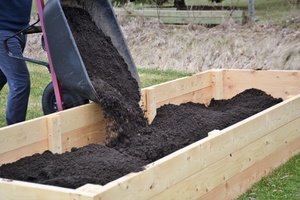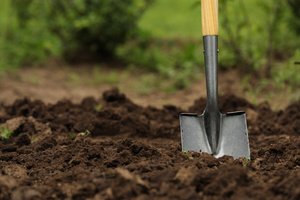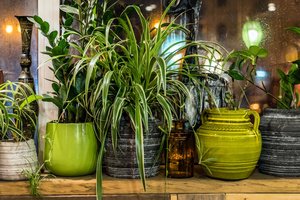Topsoil, as the name implies, is the top layer of the earth’s crust, and it provides the ideal conditions for plants to grow. However, the soil in some areas is full of debris that can impede root growth and stop shoots from reaching the surface. Screening topsoil can eliminate most of this debris and create a rich environment that is suitable for plant growth and development.

Screened topsoil can be purchased in bags or by the truckload for residential landscaping and gardening projects. However, it can be difficult to determine precisely how much soil you will need for a particular project, so it is not unusual to end up with additional topsoil at the end of the work.
If you have a significant amount of extra screened topsoil left over after your landscaping project, there is no reason to let it go to waste. Instead, there are several ways you can put this high-quality topsoil to good use and get the most for your money while beautifying your property.
Raised Beds
Excess screened topsoil can be used to fill in raised planting beds. For example, you might consider creating some raised concrete beds to grow vegetable gardens while keeping weeds out. A raised bed can add some variation in height to your landscape, making it more visually appealing while improving its drainage and providing you with opportunities to grow ornamentals.
Make Potting Soil
You can also use excess screened topsoil to make potting soil. Potting soil is lighter than typical garden soil, so you need to blend your screened top oil with other materials and compost to create potting soil.
Mixing your excess screened topsoil into existing soil can improve its friability, water-retention ability and texture. You can also add compost to it to add more nutrients to the soil. A good rule of thumb is to mix one part topsoil with one part peat moss and one part compost.
Create Berms
One clever use for excess screened topsoil is creating berms, or planted mounds or hills in your landscape. These are useful for hiding any unattractive features in your yard such as utility stations and compost piles. They may also serve as a transition between two different areas of your garden.
Form the basic structure of the berm using a rock clay soil and then add around a foot of screened topsoil over the berm; if you have enough topsoil, you can use it to create the entire berm instead. This will come with the added benefit of giving you some new gardening design opportunities.
Fill in Low Spots in Your Yard

Extra screened topsoil can be used to fill in any low spots in your lawn or garden-improving its drainage and avoiding tripping hazards. Screened topsoil is very easy to rake and grade, making it a great choice for filling in lawn areas where you intend to plant grass.
You can also use excess topsoil to fill in sinkholes that have developed in your yard as a result of the collapsing ground. When surface soil is heavier than the soil below, it may collapse and create a sinkhole, and these can be closed by filling them with any type of dirt, including screened topsoil.
Plant Trees and Shrubs
The excellent nutrient capacity of high-quality screened topsoil makes it ideal for feeding shrubs and trees and enabling them to thrive. It also possesses the ideal soil structure to develop strong roots.
You can either use it to plant new trees and shrubs or to support existing ones. Additional dirt will provide your trees with extra nutrients while also fostering moisture retention. Topsoil can also be used to form a base layer around the trees that can be topped off with mulch. The dirt will help the mulch stick to the ground and stop it from blowing away in inclement weather.
Create Compost
You can also use excess topsoil to create compost. If your yard has a compost bin, consider adding some topsoil to it; good compost will have both greens and browns, and topsoil is well suited to the latter part of the equation. When topsoil is mixed with vegetable and fruit peelings and the other items in your compost bin, it will form a nutrient-rich food that can stimulate the growth of your plants and grass and result in a healthier-looking landscape.
Bring It Inside
If you are only considering places outdoors to use your excess screened topsoil, you are missing out on one excellent potential use for it: indoor planting.

Topsoil is the perfect environment for growing herbs such as basil and dill, so consider using it to grow an indoor herb garden that can keep your kitchen supplied with a steady stream of fresh herbs throughout the year.
You can also use it to fill some pots and support house plants. This is a particularly good option for those who find growing plants outdoors intimidating. Mix your extra screened topsoil with some compost to create the perfect environment for house plants, which tend to appreciate loose topsoil that has good drainage properties. Having fresh greenery indoors is good for air quality and adds to your interior aesthetics.
Saving Excess Screen Topsoil
If you are not quite sure what you would like to do with your extra topsoil or you have a project in mind but are not ready to use it yet, you can simply find a place to store it. The most important thing to remember is that you must cover it to prevent it from washing away.
If you have a large amount of extra soil, buy some dedicated soil storage bins, fill them with your excess topsoil, and store them in a location where they will not be exposed to the elements or bright sunlight. Look for waterproof bins to protect your soil.
Contact Dirt Connections to Arrange Your Topsoil Delivery
If you are seeking an affordable source of high-quality screened or unscreened topsoil or fill dirt in the Northern Virginia area, reach out to the team at Dirt Connections. Our dirt delivery service can ensure you have the proper materials to complete your project successfully.
Summary

Dirt Connections was started with one goal in mind: providing quality residential and commercial construction services to clients on time and on budget. Reach out for more information on how we can support your next project.
For your convenience our estimates are free and by appointment. Call 703-940-9949 for a free estimate today!










































